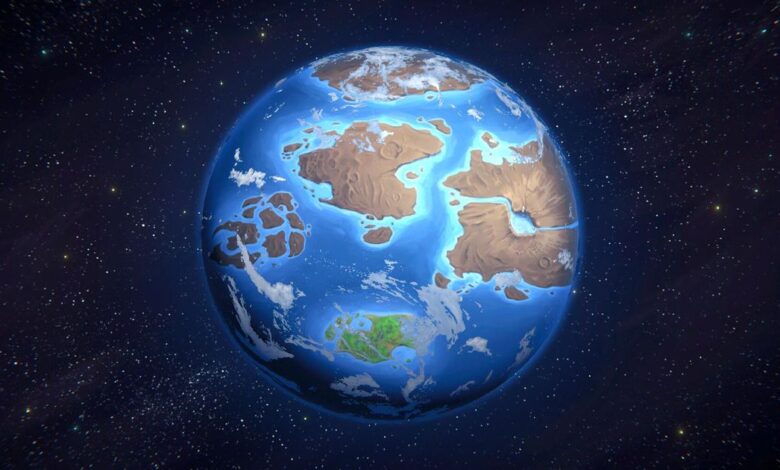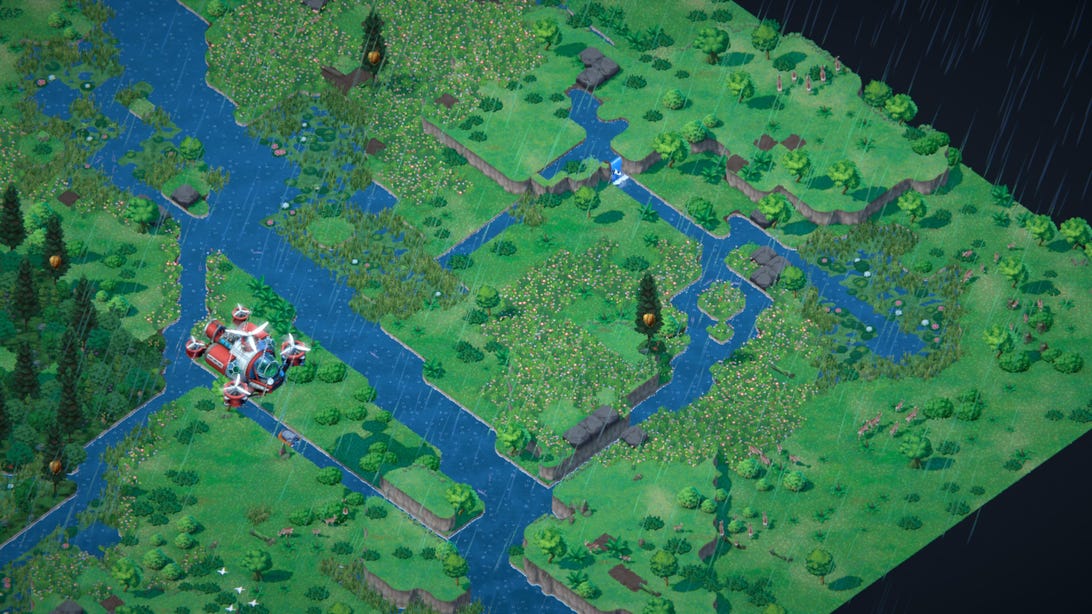Terra Nil reengineers the city-building game for a planet in crisis

[ad_1]
The Cape Floral Kingdom is under threat.
That sounds like the opening lines of a sprawling, open-world action RPG but it’s not. It’s an issue affecting a vast wonderland of unique plant life on the west coast of South Africa, one of the world’s richest areas of plant biodiversity.
The kingdom, which surrounds Cape Town, is home to a type of vegetation found only in South Africa, known as fynbos. The shrubs require fire to survive. Every decade or so, fires help replenish minerals in the soil that fynbos thrive on. Humans in the area threaten the biodiversity in the area and research has shown our activities can mess with the fynbos life cycle.
Game designer Samuel Alfred is one of those humans. The fynbos served as inspiration for Terra Nil, a recently-announced “reverse city-builder” from Cape Town-based games development house Free Lives. Alfred, the team lead on Terra Nil, looked to his surroundings for inspiration.
“I’ve always been interested in the natural world and learning about the world around me,” he says.
Terra Nil is reminiscent of other city building games, like SimCity or Cities: Skylines, with one key difference — and this is where the “reverse” in reverse city-builder comes in. “There are lots of games about building cities for people, this is not a game about people,” Alfred notes.
Instead, the idea is to rewild the wasteland by building power stations, machines and climate-altering constructions. A region can only be reclaimed once all of the buildings have been recycled, leaving the wilderness untouched. This is a game about nature, untouched by
The core idea came about during the game jam, Ludum Dare 45, which gives game developers 48 hours to develop a title based on a theme. At LD45, the idea was “Start with nothing” — that’s where Alfred’s idea first germinated. At first, the game required you to green the wasteland, dropping turbines and toxin scrubbers onto the dead earth. But after its reception during LD45, Alfred expanded on the concept.
And the fynbos of the Cape played a critical role. Their burns helped expand the gameplay loop further. “We drew inspiration from the real world, but then gamified it a little bit,” he says.
Terra Nil is already receiving a good deal of buzz. The game is currently part of Steam Next Fest, a digital festival on the games service featuring hundreds of demos, where it sits third on the most downloaded list. When I spoke with Alfred, art lead Jonathan Hau-Yoon and animator Marcelle Marais, the demo had been out for just 12 hours — but they were thrilled with the early response.
“It seems to have really resonated with people,” Alfred says.
Into the (re)wild
This is how it begins: barren, deserted, grim.
Screenshot by Jackson Ryan
The first thing you hear when you load the Terra Nil demo is the twittering of birds. A tiny joyful flourish, over the opening credits. A primer for what’s to come.
“I would find it very difficult, myself, to play the game and finish the level and be angry,” says Marais. At least from what I’ve played so far, that much is true. Each playthrough feels like a meditative experience, backed with subtle pianos, violins and the blowing of wind (and if you’re lucky enough to generate a thunderstorm, settle in with a cup of hot chocolate because it’s so damn relaxing)
In the hour-long demo, you must reclaim a single area of the wasteland, greening its cracked, brown soil and filling its empty riverways. You do so by placing buildings — wind turbines for power, irrigators that spew water onto the soil and pumps that replenish streams. There’s a Tetris-like aspect to the greening, a puzzle element which involves trying to maximize the game’s “currency” while filling the screen.
Once you’ve repopulated a region with enough greenery, you unlock the second stage of the reclamation process: improving biodiversity by creating wetlands and forests — forests which require scorched earth to build. Just like the fynbos of South Africa’s floral kingdom. Eventually, animals creep back into the wilderness.
The final stage of the game requires players to build a drone from the recycled steel used to construct the buildings. If you’ve budgeted correctly, you can build the drone and disappear to a new region, ready to rewild again.
It’s this key element, the genre-breaking aspect of Terra Nil, that genuinely feels rewarding. There’s a compulsion to leave no square un-greened.
“There’s so many games that kind of just are about exploiting resources and building up these giant civilizations, which are all great,” says Marais.
“It’s refreshing to have this approach, which is kind of taking a lot of the magic that’s in those kind of games, and reengineering it.”
Different climate
It’s impossible to make a video game like Terra Nil without examining social issues around the environment and climate. As countries plan to reduce carbon emissions and undo some of the damage humans have wreaked on the environment, Terra Nil animates the reverse destruction at light-speed. It’s a facet the team does not shy away from.
While big name studios have retreated from discussing political issues or social commentary, it’s clear the Free Lives team have thought about the kinds of messages Terra Nil might be sending.
“Video games are going to be political, whether we want them to be or not,” says Hau-Yoon.
Hau-Yoon, who helped transform Terra Nil from its game jam-era pixel art to its current “Studio-Ghibli” style, took one particular ethos into his design. Studio Ghibli films themselves often have environmental messages that seemed to fit with Terra Nil — he used Ghibli as a launching pad; inspiration to make the buildings more personal and less industrial.
But there was some pushback to the Ghibli-fication in Terra Nil’s Discord community, he notes. When Hau-Yoon read a blog post by a player from Manila, in the Philippines, his perspective of the art changed again.
An early WIP of the Ghibli art style from Jonathan Hau-Yoon (@elyaradine)
Jonathan Hau-Yoon
“His argument was that a lot of [the world’s] environmental problems are caused by industry or caused by large industrial scale buildings,” Hau-Yoon recalls. “If industrial scale things caused the problem in the first place, then we require industrial scale solutions to address them.
That was so powerful to me.”
The Ghibli-style hasn’t entirely disappeared from the current version of the game but the changes from Hau-Yoon’s earlier designs are noticeable. Just like a prescribed burn might allow South Africa’s fynbos to flourish again, tearing apart the old designs and fleshing them out seems like it has the potential to inspire a small change in player’s minds.
“What I don’t really want to do is to make it sort of like browbeating or a forced thing,” says Hau-Yoon.
Both Hau-Yoon and Alfred make it clear that this video game is not a grand statement on how climate change can be fixed. Terra Nil doesn’t whack you over the head with an environmental message. Alfred says the problems we face on Earth, outside Terra Nil’s Earth-like landscapes, are much deeper than “plopping down a couple of buildings.”
Breath of the (re)wild
One of the key criticisms around the demo has been about how “deep” the game will be. Will the process of reclamation and restoration get old or will there be enough variation to sustain interest? The challenges are a little different to other simulation games, where the world is constantly changing and reacting to events. Terra Nil is more like a puzzle.
Still, Alfred says the team is very happy with the core game loop. Now that the demo is out, the focus will now be on broadening the scope of the content. “We want to tweak it in interesting ways,” he notes. “Like say, what happens when you’re on an island? What happens when you’re in the Arctic? What rules change?”

Turning barren soil into endless greenery.
Screenshot by Jackson Ryan
As for a story or overarching narrative, there are only rudimentary plans at this stage.
“We were planning on the game having quite a subtle, implicit narrative rather than a fully voiced character story or anything like that,” Alfred says. “We kind of want players to be able to tell their own story.”
The game doesn’t have a release date or even a window (2022 is tentative, however) and there were no further hints in our interview. When it arrives, Terra Nil will be thrust, even if unwillingly, into the middle of the most important decade for climate action on Earth.
It couldn’t come at a better time.
[ad_2]
Source link





